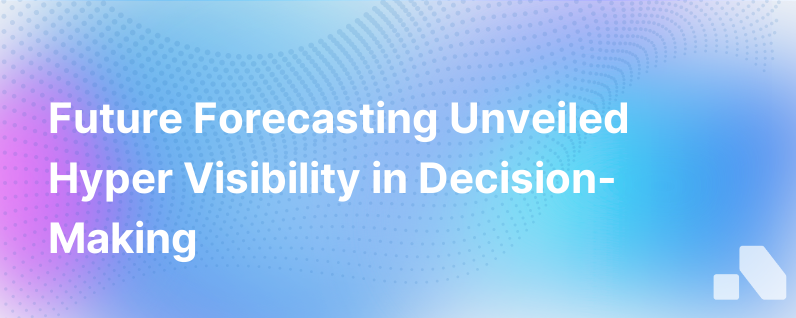
In today’s dynamic business environment, where markets fluctuate with increasing velocity and the competition is a mere click away, the capability to forecast accurately is not just a strategic advantage, it's an imperative. The future of forecasting lies in achieving hyper visibility — a state where companies have an almost clairvoyant level of insight into their operations, market dynamics, and customer behavior.
Hyper visibility in forecasting means seeing beyond the surface of one's enterprise and market, levering data to illuminate every factor affecting the business trajectory. Here we explore the contours of this emerging reality and what it might mean for businesses striving to navigate the ever-accelerating pace of change.
What is Hyper Visibility?
The concept of hyper visibility in forecasting refers to the integration and application of data-driven insights across all facets of a business to project future outcomes with unparalleled precision. It involves harnessing real-time data, predictive analytics, machine learning algorithms, and artificial intelligence (AI) to illuminate the complexities and nuances of a company's sales, financial performance, and market trends.
The Evolution of Forecasting Methods
Traditional forecasting methods, such as time-series analysis or expert judgment, have served businesses well in the past. However, they often fall short in today's volatile marketplace, where change is the only constant. These legacy techniques lack the speed and scalability required for real-time decision-making and are handicapped by their reliance on historical data and human intuition.
By contrast, today’s innovative technologies deliver live metrics, providing a granular view into present conditions and potential futures. They not only digest massive volumes of past and current data but also feed in variables from external ecosystems - such as market conditions, geopolitical events, and even weather patterns - to generate forecasts that are increasingly nuanced and accurate.
The Impact of Big Data and AI on Hyper Visibility
The emergence of big data has been a game changer for forecasting. The proliferation of data points and the capacity to process them allow forecasts to draw from a richer tapestry of information. AI algorithms analyze patterns and relationships within this data, learning over time to discern which elements are the most critical for accurate predictions.
Moreover, AI enables what's known as predictive and prescriptive analytics. Predictive analytics anticipates future scenarios based on current trends, while prescriptive analytics recommends specific actions to achieve desired outcomes. This level of computational forecasting allows businesses to model a multitude of scenarios in seconds, assisting leaders in making informed decisions swiftly.
Case Studies and Real-World Applications
Forward-thinking companies across various industries are beginning to leverage the power of hyper-visible forecasting. For instance, in retail, advanced analytics predict consumer trends, manage inventory levels, and adjust pricing in real-time to optimize sales. In finance, AI-driven models forecast market movements and identify investment opportunities before they become apparent to human analysts.
One notable example is the logistics sector, where companies employ predictive analytics to forecast shipping volumes, optimize routes, and anticipate maintenance needs, thereby minimizing downtime and reducing costs. Another is in agriculture, where hyper visibility helps predict crop yields, inform planting schedules, and manage resources more efficiently.
Challenges and Considerations
Despite its potential, hyper-visibility in forecasting comes with its challenges. The sophistication of the technology requires skilled personnel to manage and interpret the output. Moreover, data integrity is paramount; inaccurate input can lead to false predictions. There's also the risk of over-reliance on technology, where decision-makers might ignore their intuition or critical contextual information that AI may not fully grasp.
Furthermore, as businesses dig deeper into data, privacy and ethical considerations come to the forefront. How companies collect, store, and utilize consumer data is subject to increasing scrutiny. The implications of hyper visibility can therefore extend beyond business performance to corporate responsibility and brand reputation.
The Future: From Insight to Foresight
As we look to the future of forecasting, it's clear that a shift is occurring: from insight to foresight. Businesses will not only understand their current state in excruciating detail but also foresee the implications of their decisions well into the future. This will enable a move from reactive to proactive strategies — from responding to change to predicting and preparing for it.
Workflow integration and the democratization of data within an organization are also on the horizon. As forecasting tools become more user-friendly and accessible, decision-makers at all levels will be equipped with the insights they need, leading to a more agile and responsive business model.
In the ultimate realization of hyper-visible forecasting, companies will operate in a state of constant anticipation, seamlessly adjusting to fluctuations in demand, supply chain disruptions, market shifts, and even changes in consumer sentiment.
Closing: A New Paradigm in Forecasting
In conclusion, hyper-visible forecasting represents a new paradigm in business strategy. It promises to transform how companies plan, compete, and thrive amidst uncertainty. By leveraging the latest advancements in data analytics and AI, businesses can not only gain an edge over their competitors but also navigate the future with confidence.
At the forefront of this revolution, solutions like Aomni are providing B2B sales platforms the tools to sell more strategically, incorporating hyper visibility into the very fabric of their operations. With Aomni's AI-powered insights, businesses can achieve real-time account research, competitive intelligence, and personalized sales content—delivering the future of forecasting today.